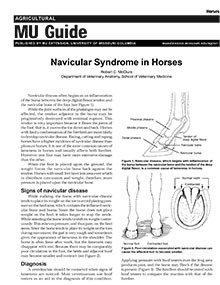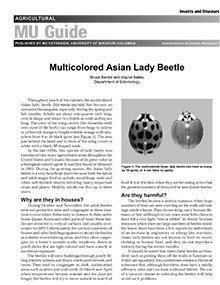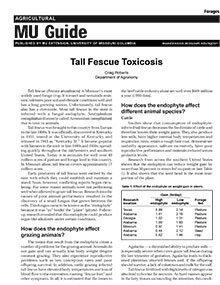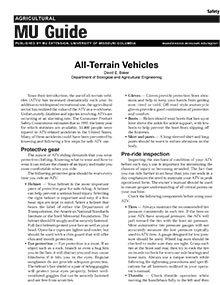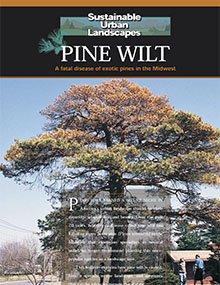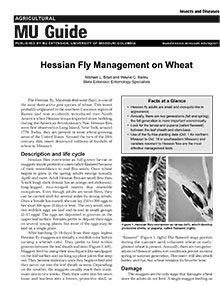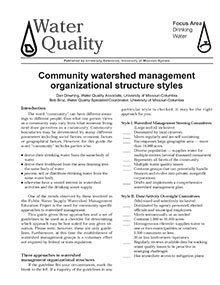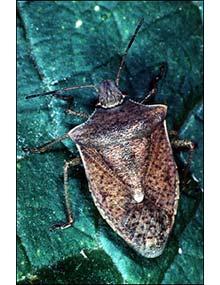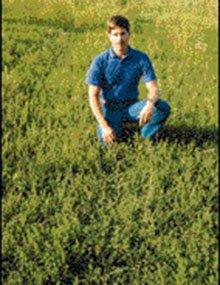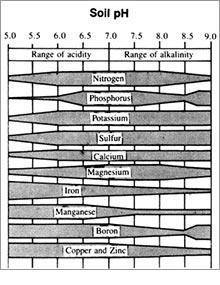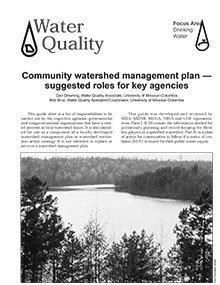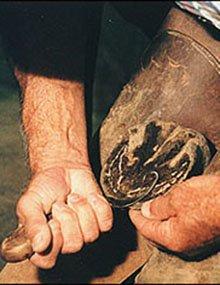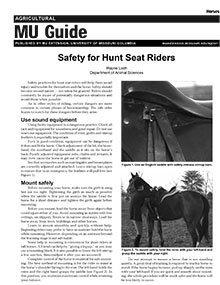Fertilizing Shade Trees
Reviewed
The main reason for fertilizing shade trees is to maintain vigor so that plants will be able to resist environmental stresses & pests. Visit our site.
Navicular Disease in Horses
Revised
Smooth Bromegrass
New
Smooth bromegrass makes for excellent quality hay. Visit our website today to learn more about smooth bromegrass.
Tall Fescue Toxicosis
New
Tall fescue is Missouri's most widely used forage crop. Visit our site to learn about Tall Fescue Toxicosis.
Child Abuse and Neglect
Reviewed
All-Terrain Vehicles
Revised
Since their introduction, the use of all-terrain vehicles (ATVs) has increased dramatically each year. In addition to widespread recreational use, the agricultural sector has realized the value of the ATV as a workhorse. Unfortunately, fatalities and injuries involving ATVs are occurring at an alarming rate. Many of these accidents could have been prevented by knowing and following a few steps for safe ATV use.
How to Prevent Electrical Accidents
Reviewed
Electricity, one of the most versatile and widely used power sources, is used extensively on almost every farm. Farmers are so familiar with electricity that they may take electrical safety for granted. When this happens, accidents often follow. Get tips for electrical safety in this guide.
Pine Wilt: A Fatal Disease of Exotic Pines in the Midwest
New
Pine wilt has killed so many Scots pine trees in the Midwest that extension specialists no longer recommend planting it in the area. Learn what causes pine wilt, how it spreads and what you can do to manage it in this full-color guide from University of M
Soybean Pest Management: Bean Leaf Beetle
New
Facts at a glanceThere are two generations of bean leaf beetle per year in Missouri.Both larvae and adults are soybean pests.
Hessian Fly Management on Wheat
New
Facts at a glanceHessian fly adults are small and mosquito-like in appearance.Annually, there are two generations (fall and spring); the fall generation is more important economically.Look for the larvae and puparia (called flaxseed) between the leaf sheath and stem base.Use of the fly-free planting date
Soybean Pest Management: Stink Bugs
New
In Missouri, the green stink bug, Acrosternum hilare (Say), and brown stink bugs, Euschistus spp., commonly infest soybean fields. Learn how to identify them and the damage they cause, how to scout for them, and how to manage them in this guide.
Annual Lespedeza
Reviewed
Annual lespedeza is an acid-tolerant, drought-resistant, summer annual legume useful for pasture, hay & soil improvement. Visit our website to learn more.
Sorghum Midge in Missouri
New
Facts at a glanceThe sorghum midge has several generations each year because of its short life cycle (14 to 16 days).Damaged seed heads are pinkish, appear blasted, and have undeveloped seeds.Begin scouting fields once sorghum starts to pollinate.Grain sorghum is less susceptible to injury if blooming is
Liming Missouri Soils
Reviewed
Functional Anatomy of the Horse Foot
Reviewed
A horse’s hoof is composed of the wall, sole and frog. Read this guide to learn more about the functional anatomy of the horse foot.
Care of Your Horse’s Feet
Reviewed
Foot care is one of the most neglected horse management practices. Most lameness that impairs the usefulness of a horse can be prevented by proper foot care and reasonable management.
Foot care should be as routine as feeding and watering. It should include:
Safety for Hunt Seat Riders
Reviewed
Safety practices for hunt seat riders will help them avoid injury and trouble for themselves and the horse. Safety should become second nature — not taken for granted. Riders should constantly be aware of potentially dangerous situations and avoid them when possible.
Small Flock Series: Brooding and Growing Chicks
Revised
Raising a flock of chickens can be difficult. Visit our website today to view our Small Flock Series: Brooding and Growing Chicks.

